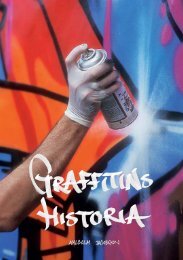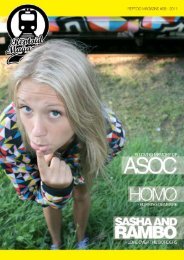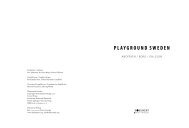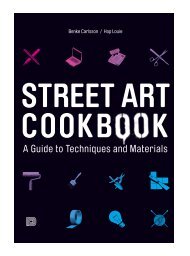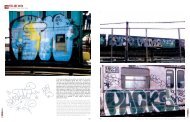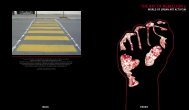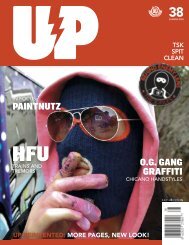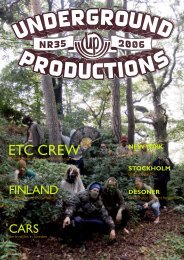BELLEVILLE IS BURNING DONUT & MARIE - Highlights.nu
BELLEVILLE IS BURNING DONUT & MARIE - Highlights.nu
BELLEVILLE IS BURNING DONUT & MARIE - Highlights.nu
You also want an ePaper? Increase the reach of your titles
YUMPU automatically turns print PDFs into web optimized ePapers that Google loves.
magic art from a forgotten era<br />
IANS<br />
the kool kieth<br />
of graffi ti<br />
<strong>BELLEVILLE</strong><br />
<strong>IS</strong> <strong>BURNING</strong><br />
graffi ti in a riot<br />
<strong>DONUT</strong> & <strong>MARIE</strong><br />
the secrets of fi nnish style<br />
FUZZ<br />
ONE<br />
will rack up your woman
Mr Nais Guy, 2005<br />
Pimping Stockholm graffiti since 2001<br />
Left page: Ians, december 2005 photo by Torkel Sjöstrand<br />
With shining style and highlights in all the right places, Ians<br />
has impressed the rest of graff Sweden.<br />
One cold November night, we talked about graffiti, Stockholm<br />
and color combinations with the president of Players Club.<br />
Ians moved to Stockholm, bought a dope ride, pimped graffiti<br />
and burned himself out<br />
Text: Torkel Sjöstrand<br />
Photos: Ians<br />
Ians turns off the engine and gets out of the<br />
car. He’s got to have the dopest car in Swedish<br />
graffiti. He says it’s “fat but discreet”. That’s<br />
how you could describe his graffiti. His style<br />
doesn’t stick out a mile, but it’s really good.<br />
So good that in the past year, Ians has sailed<br />
on to become one of the very top writers in<br />
Stockholm. Ians latches onto what’s happening<br />
and does it perfectly, develops it, and inspires<br />
others.<br />
“I don’t think I’m doing anything special,”<br />
he says humbly, and it becomes obvious<br />
that the Swedish tradition of humility is still<br />
alive and well, even in the ego trip known as<br />
graffiti.<br />
After having tried to meet him several<br />
times, I am finally led to his apartment, south<br />
of town. The apartment is full of stuff, and he<br />
is sitting fiddling with his new Ipod.<br />
“40 gig,” he grins, while the tv is showing<br />
The West Wing. Ians has 40 different channels,<br />
but says he watches less tv now than he did<br />
when he had 10. A guy is sitting sketching at<br />
the coffee table. He says hi, then makes his<br />
departure. “He comes over here to sketch<br />
sometimes,” says Ians. “He’s starting to get<br />
really good, he’s got something.”<br />
Ians comes from one of those towns barely<br />
counting 100,000 inhabitants two hours<br />
north of Stockholm, the kind of town you<br />
always get confused with the neighboring one.<br />
He says that there is only one restaurant there<br />
that doesn’t serve fillet of pork with béarnaise<br />
sauce, and that’s a Sushi restaurant. In this<br />
béarnaise-soaked town, Ians first tagged his<br />
initials when he was barely in his teens, at the<br />
back of the 11 bus. To make a long story short,<br />
by the late 90s, he was the most active writer in<br />
town. Then he moved to Stockholm.<br />
He has lived there for nearly five years<br />
now.<br />
“I like it here. It was a tossup between<br />
Stockholm and Gothenburg when I left. But<br />
Gothenburg’s too far away from my friends<br />
and family. Also, back then I was in the habit<br />
of traveling to Stockholm on weekends. I’d met<br />
some writers from the suburbs of Vallentuna<br />
and Nacka. So I went writing, partying and<br />
getting drunk there.”<br />
“Already in my teens, I knew I wasn’t going<br />
to stay in my home town, so I didn’t mind<br />
moving.”<br />
“It’s in my bones. Some people play golf, I write graffiti.”<br />
In the meantime, his grandmother died<br />
and left him some money. Thanks to that, he<br />
could move to Stockholm and start his own<br />
business* with some friends.<br />
“I told my mom to hold onto the money<br />
for me, so I didn’t waste it. So later, when I<br />
was offered the chance to become a co-owner<br />
of the firm, it felt like the right thing. The<br />
alternative was to leave off stealing and selling<br />
booze, which wasn’t very tempting.”<br />
The work proved to require a lot of car<br />
UNDERGROUND PRODUCTIONS 33 [2006] 9
Mar, Don in Vaasa<br />
The Finnish state of mind<br />
Finnish graffiti is an unknown quantity. No graffiti magazines<br />
are regularly published in Finland, and few cities are as<br />
sterilized as Helsinki. On the other hand, Finnish graffiti<br />
offers a large selection of fresh, innovative styles and a great<br />
influence on Swedish graffiti.<br />
Text: Tobias Barenthin Lindblad<br />
Photo: Do<strong>nu</strong>t & Marie<br />
When the Finnish winter hits and temperatures<br />
reach 25 degrees celsius below freezing, you<br />
may want to put your spray cans on the shelf.<br />
up took this opportunity to ask a few questions<br />
to Do<strong>nu</strong>t and Marie, two writers from Vaasa<br />
who live in Helsinki and Turku.<br />
There are so many good writers and yet so<br />
few who know about it. How can Finland be<br />
such a treasure trove of graffiti?<br />
Marie: I can imagine that, for an outsider,<br />
Finnish graff is mysterious and fresh because<br />
it’s not so well documented. Finnish graffiti is<br />
good but, it’s nothing to get all excited about.<br />
The grass is always greener on the other side.<br />
Do<strong>nu</strong>t: I agree on that there are a great <strong>nu</strong>mber<br />
of good writers in here. Finland is quite<br />
hidden from graffiti media. I think that many<br />
younger writers in Finland are inspired by<br />
crews like cdc and ftc these days. They keep<br />
it up with their example and influence to the<br />
younger ones.<br />
What’s special about Finnish graffiti?<br />
Marie: The difference between painting in Finland<br />
and Sweden is the social aspect. We Finns<br />
mostly keep to ourselves.<br />
Do<strong>nu</strong>t: I try not to be provoked by the authorities’<br />
policy. I haven’t been writing as<br />
long as some others, but I know that a writer<br />
has to be able to adapt. The circumstances<br />
change all the time. In Vaasa for example,<br />
a lot changed in the last few years. Many<br />
people started to hit the trains in this small<br />
town. Some got caught and we lost Finland’s<br />
biggest legal Hall of Fame, and soon everybody<br />
weren’t hanging out together anymore.<br />
In Helsinki and the capital area things are<br />
made a bit harder for writers. Here the situation<br />
has been bad since the late 90s. Worse<br />
than it has been in Stockholm. This has to do<br />
with the zero tolerance policy in Finland but<br />
it’s also a part of the Finnish state of mind.<br />
Marie: In my town, whether it’s Vaasa or<br />
Marie<br />
Turku, graff is seen as something negative. I<br />
believe that most people don’t have an own<br />
opinion about graff, but have rather been<br />
handed one. Some people think that tagged<br />
places are dangerous and might even try to<br />
avoid them. This is of course a result of the<br />
idea that media gives of who graffiti writers<br />
are.<br />
Your styles look very 70s. What are your<br />
influences?<br />
Do<strong>nu</strong>t: The funky 70’s are important to me.<br />
Still, I’ve mostly been influenced by Scandinavian<br />
and particularly Finnish writers. When I<br />
started with straight lines, writers like Kaput<br />
and Jeans made a big impression on me. Today<br />
I like Lucy, Trama, Syno, Chile and Vamp<br />
amongst others. There are so many writers<br />
to look up to. I also like many Swedish writers,<br />
and my favourite is grand master Sken.<br />
Marie: In graff you can take influences from<br />
anywhere. For me it’s mostly about tradition<br />
and trying to give back some of what<br />
I’ve taken. I’m into oldschool New York and<br />
Nordic style kings like Nug, Sken and Egs<br />
14<br />
UNDERGROUND PRODUCTIONS 33 [2006]
Fame crew in Barcelona, Spain. Winter 2005.<br />
Trans-Europe Express<br />
Graffiti writers from all corners travel worldwide to<br />
paint. Trips around Europe and to New York have been<br />
a longstanding tradition, whilst Asia and South America<br />
are becoming more usual destinations in later years. For<br />
hardcore practitioners it’s all about painting as many trains<br />
as possible; whoever paints the most subway systems wins.<br />
Text: Torkel Sjöstrand<br />
“See you at the station,” says Rage on the<br />
phone.<br />
My traveling companions and I are sitting<br />
in a car outside Hamburg. Most of the bridge<br />
foundations along the road are covered in<br />
graffiti, many with DSF pieces: Die Staats<br />
Feinde (Enemies of the State), which is Rage’s<br />
crew. Barely thirty mi<strong>nu</strong>tes later, we have<br />
found the station and hear someone calling.<br />
Rage is standing a bit further away with two<br />
friends, waiting for a wholecar they did earlier<br />
that day.<br />
Traveling to another city or country as<br />
a graffiti writer is different from the usual<br />
tourist’s jaunt. To the initiate, tags and pieces<br />
communicate directly. You attentively note<br />
whose pieces are most visible, whose are<br />
baddest, or whose can’t be seen at all. And the<br />
hope of getting your own tag up grows. “I had<br />
a few hours to kill over there and saw a couple<br />
of trains. So I jumped down and did a few<br />
tags and throw-ups,” says the American Merc<br />
One about his visit to Mannheim, Germany.<br />
In the mid-80s, he bombed letterlines in New<br />
York. European graffiti tours of today have<br />
their origins in the mid-80s. Zebster, Loomit<br />
and Chintz were some German pioneers, who<br />
went writing in Stockholm in the late 80s. For<br />
Swedish writers, Copenhagen was the first<br />
stop on the European tour.<br />
Todays European traveling is widespread.<br />
Thanks to the opening of the borders, graffiti<br />
writers move around quickly and smoothly<br />
like anyone else. The most popular means<br />
of transport so far has been by train on the<br />
Interrail card system.<br />
Rage has taken us to a party on the<br />
Reeperbahn Boulevard. The stairwell is<br />
bombed. Familiar tags from both Hamburg<br />
and Berlin make an appearance. There are<br />
a lot of people, beer and drunkenness at the<br />
party. By the time we leave, it’s getting out<br />
of hand. The host is starting a fight with a<br />
drunk guy from Saarbrücken, which ends in<br />
an enraged pillowfight. Lamps and furniture<br />
are smashed.<br />
24 hours later, we follow the crew Colors<br />
On Steel (COS) into a tunnel shaft leading to<br />
a subway yard. But the cleaners are working<br />
slowly, and the guards won’t leave. There’s<br />
no painting that night. The following day, we<br />
travel to Liège, in Belgium.<br />
Travel in Europe became even more<br />
common during the mid-90s. Crews were<br />
formed, bridging cities and national borders.<br />
Phone <strong>nu</strong>mbers were exchanged, then email<br />
addresses. Appointments were made at train<br />
stations. People would look for a face to<br />
match the broken English known only from a<br />
phone call. Graffiti enthusiasm was sufficient<br />
to bring the most different people together.<br />
By the late 90s, graffiti had grown strong<br />
in southern Europe, and many East European<br />
countries started laying the foundations for<br />
graffiti scenes. Berlin writers visiting the Czech<br />
Republic and Poland made strong impressions<br />
on the nascent local scenes.<br />
One reason to pack your backpack is the<br />
chance to be ‘all city’ in a town other than<br />
your own. Early this decade, O’clock, the<br />
notorious Paris bomber, had been visible in<br />
Brussels and Amsterdam, not to mention New<br />
York. “That French boy, O’clock, he was here.<br />
34<br />
UNDERGROUND PRODUCTIONS 33 [2006]
Que and Ebony in Amsterdam, Holland, 2005<br />
Trc and Mbee in Austria, 2005<br />
He made a lot of mess,” says Merc One. New<br />
Yorkers, otherwise known for looking no<br />
further than their own nose, had noticed the<br />
young Frenchman.<br />
We wait for Nutmeg at a café on Rue de la<br />
Madeleine in central Liège. The area is pretty<br />
shabby, and the landlord lights a giant spliff<br />
after serving our coffee. Nutmeg laughed a bit<br />
on the phone when he said Rue de la Madeleine<br />
would be a good place to meet. When we meet<br />
him later, he says the street is in the middle of<br />
Liège’s red light district, and doesn’t think we<br />
should keep our car parked there.<br />
Nutmeg says he feels warmed up and wants<br />
to go and paint a train. He speaks English with<br />
a strong French accent, and uses sounds and<br />
gestures when he can’t think of an English<br />
word.<br />
The next day, he shows us an abandoned<br />
building where they often paint. The house is<br />
big, and Nutmeg mentions that it is easy to<br />
get lost in. There are tags everywhere, often<br />
with the thought-out tags that characterize his<br />
crews, Toy and Ers.<br />
Most traveling graffiti-writing Europeans<br />
want to paint trains in other cities and<br />
countries. One of the first questions the<br />
train writer asks is about how well-guarded<br />
the trains are and what happens if you get<br />
arrested. The latter event occurs regularly. In<br />
Stockholm, police seem to have no guidelines<br />
Uze in Athens, Greece, 2005<br />
concerning the arrest of foreign writers. In the<br />
late 90s, an Italian was apprehended for two<br />
weeks, while a year later, a German got four<br />
weeks; a Spaniard got away with eight hours.<br />
To the chagrin of plainclothes subway guards,<br />
one Frenchman they caught was immediately<br />
released by the police after his arrest.<br />
Subways are the hottest destination.<br />
Nowadays, fewer people bother to contact<br />
local writers. Instead, all their time is spent<br />
painting subways, sleeping in parks, painting<br />
another subway, and then getting the train to<br />
the next city.<br />
After a ten-hour drive, we arrive in Milan.<br />
The city is scorching hot, and humid, smogfilled<br />
air lies like a second skin over your body.<br />
We are met by a friend of a friend, and follow<br />
his scooter through the chaotic traffic that<br />
distinguishes Italy.<br />
Later, we meet Sand, who has been part<br />
of Milan’s train-painting core for some time.<br />
Sand shows us around graffiti stores and parks.<br />
With him, we also meet one of Milan’s most<br />
active young train painters. Alternatives for<br />
painting the subway are discussed. In one final<br />
desperate alternative, a complete kamikaze<br />
action is spoken of. There’s about a one-in-ten<br />
chance the guards won’t come, they say.<br />
It ends with a painted interregional train.<br />
It goes smoothly. The only encounter we<br />
UNDERGROUND PRODUCTIONS 33 [2006] 35
Möe<br />
Skate Music, character by Chess, Josh<br />
Tom<br />
Möe<br />
Möe<br />
Step Chess Möe<br />
42<br />
UNDERGROUND PRODUCTIONS 33 [2006]
Möe painted in a shower<br />
“Toys have more style than us”<br />
Ironic, naivistic and attractively ugly graffiti has been around<br />
for more than ten years, but you can still cause provocation<br />
with styles that question our notion of good graffiti. Möe is<br />
a Norwegian crew that takes ugly graffiti to new heights of<br />
beauty.<br />
Text: Malcolm Jacobsson<br />
Photos: Möe<br />
It started at a party on New Year’s Eve of<br />
2000, when Ussr mentioned a new word he’d<br />
invented: Möe.<br />
His friends liked it, and they decided to start a<br />
crew. Möe had no exact meaning. Sometimes it<br />
means ‘Children of Our Times’, other times it<br />
means ‘Concrete Kings’ or ‘Street Warriors’.<br />
What’s so special about Möe?<br />
“We have several different styles and<br />
ways of practicing graffiti. One of us might<br />
paint some subways in very simple style,<br />
while others break off from the traditional<br />
understanding of what a tag or piece can be.<br />
We use a lot of humor and self-irony, and our<br />
approach to graffiti is relaxed. It’s just one of<br />
the many things we do to feel alive,” says a<br />
Möe member.<br />
Möe is a gang of friends who work a lot<br />
together. They inspire each other, but also<br />
compete within the crew. Sometimes they<br />
experiment, each sketching up every other<br />
letter or exchanging sketches. They get<br />
inspiration from amateur graffiti and 70s<br />
or early 80s New York graffiti. But also<br />
Norwegian graffiti, like oldschool legends<br />
Mack and Bits and todays All crew.<br />
Josh<br />
Ekaf<br />
UNDERGROUND PRODUCTIONS 33 [2006] 43



